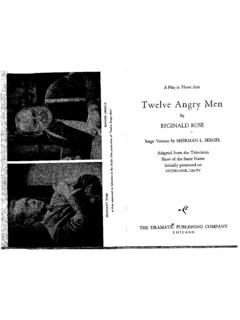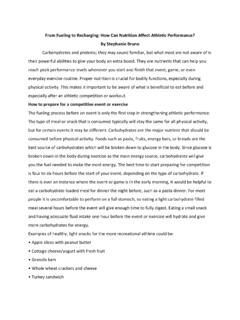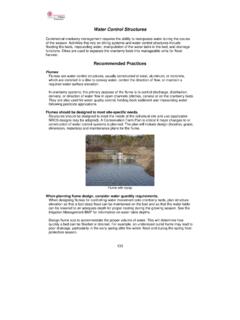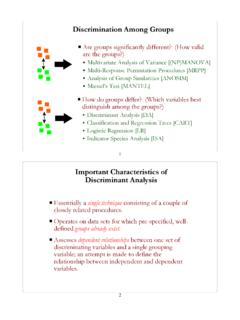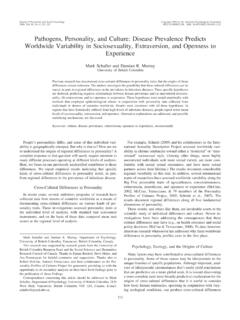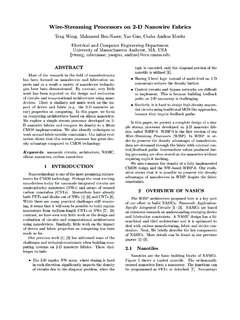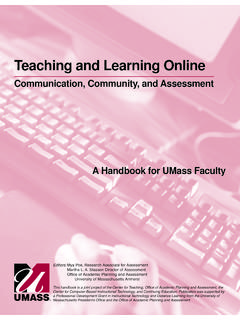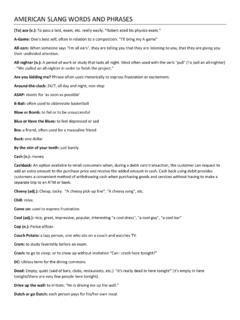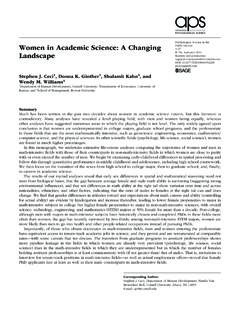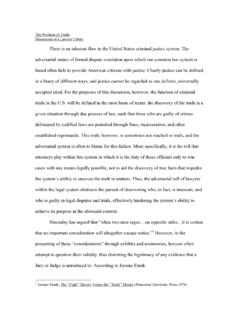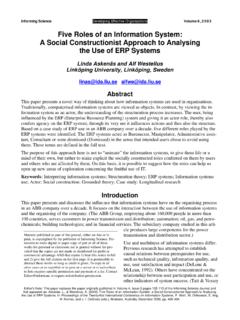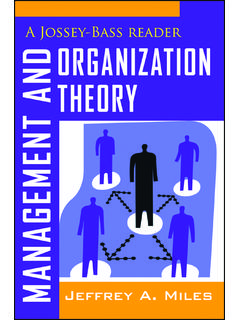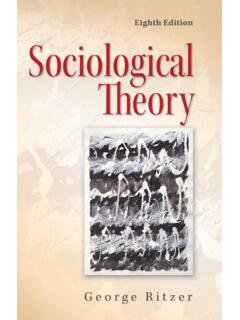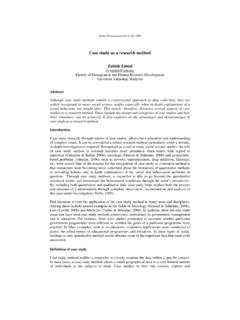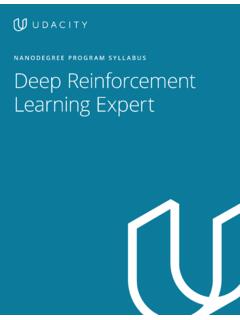Transcription of Sample Independent Study Proposal #1
1 Sample Independent Study Proposal #1 Independent Study ProposalThe Representation of Housewives in the media, in the 1950 s1. A Statement of the purpose/goals of the projectThe purpose of my project is to Study how films contributed to the images of married women and observe ifthese images reflect the ones found on other 50 s A description of the subject matterMy subject matter will include films that were nominated for awards from 1950-1959. For a second mediato contrast my findings in the films I will research magazine articles written in the 50 s, intended formarried women. To gain a different perspective I will use Life or Look magazines and Time or Newsweekmagazines. I will observe the characters of the married women and their roles both in society and thefamily unit. I will compare the images I find to the advice in the magazine An explanation of its relevance to my interests and major area of studyThis subject is relevant to my life in several ways.
2 As a communication major I have studied both film andother forms of media throughout my college career. I enjoy studying films from all decades and am veryinterested in the portrayal of women in the mediums of film and music. As a woman this subject isinteresting to me, in seeing how far the images of married women have come in fifty A Description of my proposed research methodologyFor my research I will be viewing the movies nominated for academy awards from 1950-1959. Thesemovies will represent films thought of as the best of their year by the academy and will be available onvideo for me to find. I will also look up old reviews written about the movies during their time period. Iwill look in archives to find the magazine articles from the 50 will conduct a textural analysis of the films and watch for images that female stars create as theperfect wives. This analysis will also include advertisements.
3 In the magazines I will also be looking foradvertisements directed towards women and the images these convey and will continue the textual analysisto advise articles written specifically for A preliminary working bibliography1950: All About Eve, Born Yesterday, Father of the Bride, Kings Solomon s Mines, and Sunset Blvd1951: An American in Paris, Decision before Dawn, A Place in the Sun, Quo Vadis?, A Street Car Named Desire1952: The Greatest Show in Earth, High noon, Ivanhoe, Moulin Rouge, and The Quiet Man1953: From Here to Eternity, Julius Caesar, The Robe, Roman Holiday, and Shane1954: On the Waterfront, The Caine Mutiny, The country Girl, Seven Brides for Seven Brothers,Three coins in a fountain1955: Marty, Love is a many splendored thing, Mister Roberts, Picnic, and The Rose Tatoo1956: Around the World in Eighty Days, Friendly Persuasion, Giant, The King and I, The TenCommandments1957: The Bridge on the Rive Kwai, Twelve Angry Men, Peyton Place, Sayonara, Witness for the Persecution1958: GiGi, Auntie Mame, Cat on a hot tin roof, Defiant Ones, and Separate Tables1959: Ben Hur, Anatomy of a murder, Diary of Anne Frank, A Nun s story, A room at the TopAmber, George.
4 The New York Times Film Reviews. Arno Press Inc; New York, 1971 Bohn, Thomas and Stromgren, Richard. Light and Shadows, A History of Motion Publishing Co.; California, , Hortense. Hollywood the Dream Factory. Little, Brown and Company; Boston,1950 Time magazine, Newsweek, and Life Magazine will be used for my research as Information on the form and Length of the final report:I would like to do a fifteen page paper on my research. The paper will include my findings, and theevidence with which I came to my #2, Independent Study ProposalA Content Analysis of Time and Newsweek1. Purpose/GoalsThis proposed Study is about the media coverage of America s war on terror. Since theSeptember 11th attack on the World Trade Center, news coverage has been both lengthy and intense. Theconsequent war in Afghanistan has been the subject of long periods of saturation coverage.
5 To the extent that theaverage citizen knows anything about the Middle East, it is from information provided by the news , the news media play a major role within our democracy; the decisions voters and policy makersformulate are based upon information gathered and packaged by news organizations. It is therefore crucial to thehealth of our democracy that American citizens continuously evaluate and re-evaluate the Subject MatterI began my critique by looking at two content analyses of the news. In Is Anyone Responsible:How Television Frames Political Issues, Shanto Iyengar found that during the 1980 s, network newscasts showedhundreds of reports of particular acts of terrorism, but virtually no reports on the socioeconomic or politicalantecedents of terrorism (Iyengar 2).
6 In other words, information about underlying historical, economic, or socialcircumstances of terrorism, did not accompany news about specific terrorist acts. He described news as beingframed episodically, rather than thematically. The episodic news frame focuses on specific events into somegeneral context. The essential difference between episodic and thematic framing is that episodic framing depictsspecific, what Amherst College Professor Barry O Connell refers to as, illustrations of the already known. Thematic framing presents collective or general evidence to put the already known into a broader stories framed episodically are event-oriented reports that depict terrorism issues in terms of particularinstances. The thematic frame, by contrast, places terrorism issues in some more general abstract context and reporthistorical conditions and/or general used content analysis to expose the degree in which news was framed episodically asopposed to thematically.
7 He defined content analysis as a systematic effort to classify textual material (Iyengar18). Iyengar used the abstracts of daily network newscasts as his texts. His Sample consisted of every story airedby ABC, CBS, and NBC from January 1981 to December 1986. Using a keyword search, Iyengar specified hissample to stories about crime, terrorism, poverty, unemployment, and racial inequality. He then put each story intoeither the episodic or thematic category in order to assess the degree of thematic or episodic framing in televisionnews. The episodic category (which proved most frequent) consisted of stories that depicted issues predominantlyas concrete instances or events, while the thematic category included stories that depicted issues more generallyeither in terms of collective outcomes, public policy debates, or historical trends (Iyengar 18).
8 Utilizing a multiple method research approach, Iyengar found that exposure to episodic news makesviewers less likely to hold public officials accountable for the existence of some problem ( terrorism) and alsoless likely to hold them responsible for alleviating it (Iyengar 2). Iyengar surveyed residents of the Three VillageArea of Suffolk county (Eastern Long Island, New York). The Sample was gathered through newspaper and otheradvertisements, which offered ten dollars in exchange for participation in television research (Iyengar, 20). Partof the Sample viewed news reports framed episodically, while the other part viewed reports framed members were then each required to answer a series of open-ended questions about the issues that had beenreported to each of them via the news. In regards to terrorism, those being surveyed were asked what causesterrorism and what is the best way to reduce found that the attribution of responsibility is a function of how the news story frames the issue.
9 Asdefined by Iyengar, casual responsibility focuses on the origin of a problem, while treatment responsibility focuseson who or what has the power to alleviate (or forestall alleviation of) the problem (Iyengar 8). By presenting thenews in either thematic or episodic form, the news story influences attributions of responsibility both for the creationof terrorism (casual responsibility) and for the resolution of terrorism (treatment responsibility) (Iyengar 3).The other content analysis that I studied is Herbert Gans Deciding What s News: A Study of CBS EveningNews, NBC Nightly News, Newsweek and Time. Like Iyengar, Gans text, or unit, is the individual news story. Hisobservations come from six-month samples of stories appearing in alternate months during 1967, 1971, and 1975 (Gans, 6). Gans classified stories by which actor or activity dominated each.
10 He further classified the actorcategory into three sub-categories: Types of People in the News, Knows in the News, and Unknowns in theNews (Gans 9, 10, 13).(continued) Sample #2, Independent Study Proposal3. Explanation of RelevanceThis Independent Study will afford me the opportunity to learn a valuable media analysistechnique, to work with print media, and to apply what I have learned to the discourse analysis component of mythesis. I am currently working on an evaluation of television news coverage of the Middle East using an audienceresearch method for my honors Research MethodologyI will conduct a content analysis of Time and Newsweek to determine the degree to which theycover the war on terror in episodic or thematic frames. I would also like to break down the episodic news framesinto actors ( knows and unknowns ) in order to get a sense of who speaks?
